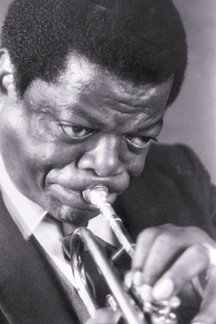

[ Metro | Metroactive Central | Archives ]
Suite Sounds Of Peace
 Ambassador of Music: Eddie Gale, San Jose's tireless jazz messenger, is a man on a musical mission of inner peace. On his new album, San Jose's Eddie Gale pursues a global brand of jazz By Nicky Baxter It was hard not to chuckle with admiration when, flipping over the dust jacket for Eddie Gale's most recent release, I noted the listing of the trumpet player and composer as "Ambassador of Music," an official designation given him by former San Jose Mayor Norman Mineta 22 years ago. Gale takes the title and position very seriously, and few insiders doubt that the Brooklyn native has earned the designation. Over the years, he has worked with a myriad of organizations as a kind of jazz propagandist, lecturing, hosting seminars and, of course, performing. To say that Eddie Gale is a man on a mission is an understatement. Gale's latest album, Inner Peace Suite #2: Eddie Gale and His Quiet Times/Inner Peace Orchestra (Life Force Records), is the culmination of the musician's lifelong pursuit of genuine world music--which is to say music whose appeal transcends language, culture and politics. It is also a way of making his own statement on global peace. In keeping with Gale's ambassador status, Inner Peace Suite #2 was recorded live at San Francisco State University before an international delegation commemorating the 50th anniversary of the United Nations. Amid the profusion of multilingual, elegantly wrought pleas for peace at the event, Gale's 14-piece orchestral maneuvers required no translation, no expository remarks. Of the album's eight tracks, six are revisions of previously recorded Gale compositions. "Water Cave" and "Kalimba and Friends," for instance, first appeared on 1991's Quiet Times & Inner Peace, the new disc's thematic precursor. "African Sunshine" and "Warm" both turn up on the highly lauded Mapleshade session A Minute With Miles. These tunes were initially recorded with small ensembles; the full-scale, orchestrated renditions add flesh and new spirit to the originals. This is particularly true of "Water Cave" and "African Sunshine." Essentially a New Age notion with a jazz makeover, "Water Cave" is here more expansive, weightier. The added dimension is due in no small part to double bassists Richard Duke and Allen Santos. Their hypnotically reiterative playing is somewhat reminiscent of John Coltrane's various ensembles, in which the reed player deployed a pair of bassists to help ground his increasingly experimental music. Duke and Santos' playing also illustrates the awe-inspiring musicality of the bass. No matter how marvelous everyone else's playing is, it takes a great deal of resolve to shift your attention away from what the two bassists are doing. "African Sunshine," a composition whose lineage is as lengthy as it is intriguing, is an even more compelling work. Its origins extend all the way back to the 1970s, when it was first released as a pop-jazz single complete with a vocal track. Through the years, Gale continued to tinker with the tune in the studio and onstage. By the time it cropped up on A Minute With Miles three years ago, "African Sunshine" had metamorphosed into an eight-minute excursion to the Motherland via classic Coltrane, with a glance even farther back to another great ensemble. Gale's terse, muted trumpet oozed a Kind of Blue -era Miles Davis, while saxophonist Ismael Navarrete launched heroic flights into Coltrane airspace. It is difficult to believe that there would be room for improvement, but the tune's ripe and complex beauty is revealed in all of its manifold beauty on Inner Peace Suite #2. At 18 1/2 minutes, Gale and orchestra have plenty of time to explore every nuance of the song. For this rendition, Gale states the theme on flugelhorn, accompanied by rolling-thunder percussion and, again, gorgeously articulated plucked and bowed double bass. The reed section--Navarette (baritone and soprano saxophones) and Jimmy Garrison (tenor)--embellishes the motif with some inspired playing. Midway, a pair of violins introduce an improvisational period that ebbs and flows like the Nile. Except for a poorly recorded piano solo, "African Sunshine" is a fully realized work whose arrangement manages to incorporate European classicism without losing sight of its Nubian roots. The concert concludes with the orchestra's rendering of the old New Orleans stomp-and-shout number "When the Saints Go Marching In." Given its association with improvisational-music's first ambassador, Louis Armstrong, the inclusion of the tune made perfect sense. Indeed, "Saints" turned the button-down crowd into a mass of Mardi Gras revelers. And they were all speaking the same language.
[ Metro | Metroactive Central | Archives ] | ||||||||||||||||||||||||||||||
This page was designed and created by the Boulevards team.
Copyright © 1996 Metro Publishing and Virtual Valley, Inc.